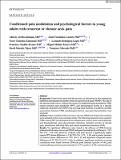Por favor, use este identificador para citar o enlazar a este item:
http://hdl.handle.net/10261/340298COMPARTIR / EXPORTAR:
 SHARE
BASE SHARE
BASE
|
|
| Visualizar otros formatos: MARC | Dublin Core | RDF | ORE | MODS | METS | DIDL | DATACITE | |

| Título: | Conditioned pain modulation and psychological factors in young adults with recurrent or chronic neck pain |
Autor: | Arribas-Romano, Alberto; Fernández-Carnero, Josué; González-Zamorano, Yeray; Rodríguez-Lagos, Leonardo; Gurdiel-Álvarez, Francisco; Molina-Álvarez, Miguel; Morales Tejera, David; Mercado, Francisco | Palabras clave: | central pain mechanism central sensitization conditioned pain modulation neck pain chological factors |
Fecha de publicación: | 2023 | Citación: | Pain Practice : 1–12 (2023) | Resumen: | Background: Controversy exists with the presence of alterations in descending pain inhibition mechanisms in patients with non-specific neck pain (NSNP). The aim of the present study was to evaluate the status of conditioned pain modulation CPM, remote pressure pain thresholds (PPT), and psychological factors in a specific subgroup of patients with NSNP such as young adult students. In addition, possible associations between CPM, psychological factors, and pain characteristics were analyzed. Methods: Thirty students with recurrent or chronic NSNP and 30 pain-free students were included in this cross-sectional study. The following measures were assessed: CPM, remote PPT, psychological factors (depression, anxiety, pain catastrophizing, and kinesiophobia), pain characteristics (duration, intensity, severity of chronic pain, interference with daily life), and central sensitization inventory (CSI). Results: No significant differences were found in the efficacy of CPM between students with chronic or recurrent NSNP and pain-free students (β coefficient = −0.67; 95% CI = −1.54, 0.20). However, students with pain showed a significantly higher remote PPT (mean difference = −1.94; 95% CI = −2.71, −1.18). and a greater presence of anxious (mean difference = 6; 95% CI = 2, 9) and depressive symptoms (mean difference = 8.57; 95% CI = 3.97, 13.16). In addition, significant moderate or strong correlations were found between CPM and pain intensity (partial r = 0.41), pain catastrophizing and mean pain intensity (r = 0.37), grade (r = 0.50), and interference of pain (r = 0.57), kinesiophobia and disability (r = 0.38), and depression and CSI (r = 0.39). Conclusions: Young adult students with chronic or recurrent NSNP present remote hyperalgesia and symptoms of depression and anxiety but not dysfunctional CPM. | Versión del editor: | https://doi.org/10.1111/papr.13313 | URI: | http://hdl.handle.net/10261/340298 | ISSN: | 1530-7085 | E-ISSN: | 1533-2500 |
| Aparece en las colecciones: | (IQM) Artículos |
Ficheros en este ítem:
| Fichero | Descripción | Tamaño | Formato | |
|---|---|---|---|---|
| Pain Practice. 2023.pdf | Artículo principal | 395,1 kB | Adobe PDF |  Visualizar/Abrir |
CORE Recommender
NOTA: Los ítems de Digital.CSIC están protegidos por copyright, con todos los derechos reservados, a menos que se indique lo contrario.
